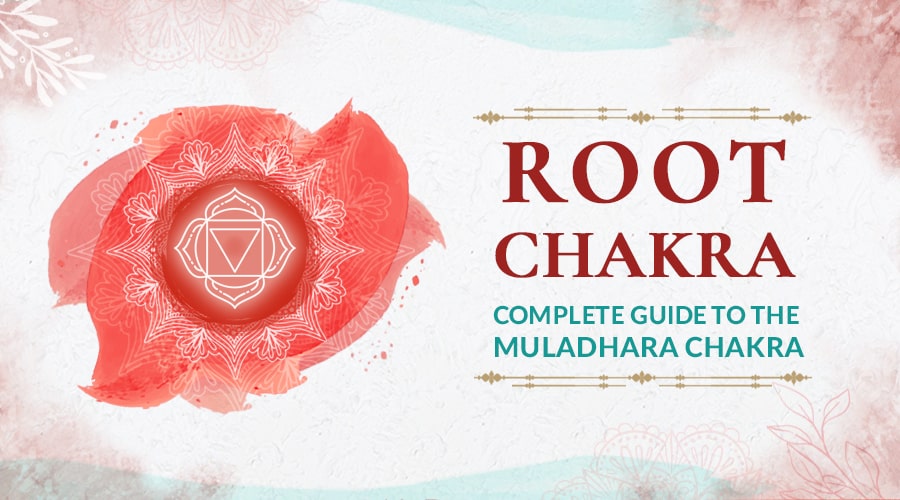The 7 chakras are the primary energy centers of the body. These chakras distribute the five pranas throughout the body and maintain a harmonious balance that preserves and restores overall health. The first chakra in the group is the Muladhara Chakra, also known as the Root Chakra.
Understanding the first chakra in our energy body is key to balancing the energy system and achieving physical, mental, and spiritual well-being. This comprehensive guide will explore the Root Chakra in-depth, revealing what it is, where it is located, and how best to heal it using yoga, meditation, and affirmations.
What Is the Root (Muladhara) Chakra?
The Root Chakra is the foundation of the physical structure of the body. The word Muladhara is composed of two Sanskrit words: "mula" meaning “root” and "adhara" which means “base” or “support”.
The Muladhara Chakra is based on the earth element and radiates the color red. Balancing it creates a solid foundation for opening all the other six chakras, promoting stability, confidence, energy, and strength.
Where Is the Root Chakra Located?
The Root Chakra is the first chakra in the energy body, located at the base of the spine at the perineum, between the anus and the genitals. Its location signifies its role as a link between the physical world and our internal energetic system.
When this energy center is balanced, we feel grounded, stable, confident, and strong in the world. Conversely, a blocked or imbalanced Root Chakra can lead to feelings of insecurity, anxiety, stress, and a loss of personal bearings.
What Is the Root Chakra Responsible for?
The first chakra is the center of Apana Prana. Apana is the vital force required for all the excretion functions. Apana prana is necessary for removing the toxins from the body and refreshing the earth element. If the earth element is not refreshed regularly, it rots in the body and causes a variety of physical and mental diseases.
Characteristics of the Root Chakra
Element
Root Chakra regulates the earth element in our bodies. It does so by distributing Apana Prana, which helps refresh the earth element we get from the food we eat. All food that grows on the earth contains the earth element, some more and some less.
The energies of this this chakra help in recognizing our strong connection to the earth. Keeping us rooted to our inner self spreads positivity and happiness in life. It relates to our basic, primal needs of survival, stability, and support, and represents the structure of our body, bones, flesh, and skin. Therefore, proper regulation of the earth element is very important for good health.
Color
It is important to know that the chakras are made up of energy only, so they don’t have their own color. But each of the seven chakras reflects the colors of their elements and surroundings.
The Muladhara Chakra is surrounded by the element earth so it reflects the color deep red. The Root Chakra color symbolizes primal instincts of strength and vitality. The red color is also linked to our physical and emotional needs of survival and self-preservation.
Symbol

The Root Chakra symbol is a four-petalled lotus flower consisting of a square, an inverted triangle, and the seed mantra LAM लं symbol in the center.
The four petals of the lotus flower are believed to represent the four earthly elements i.e earth, water, fire and air. Together, they unite to form the physical world or prakriti. The fifth element space is not included because it is not visible to the human physical eye.
Mantra
Each chakra has various sounds which arise from its movements. The combined sound is called seed mantra. The seed mantra of Muladhara is Langm (लं). Chanting the Root Chakra Mantra in yoga and meditation can awaken and activate this vital energy center and bring balance to the chakra system.
Emotions, Mental Health & the Root Chakra
A balanced Root Chakra can provide emotional strength in the face of fear and anxiety. This results in feeling grounded and secure. However, an imbalance here can cause a variety of mental illnesses and stress which can also affect overall physical wellness. The Muladhara Chakra is associated primarily with survival. Other emotions linked to this energy center include:
- Feeling safe
- Feeling secure
- Survival mindset
- Feeling grounded
- Self-preservation
Signs & Symptoms of a Blocked Root Chakra
Emotional Symptoms
Food, water, shelter, and survival are our primary needs. The main responsibility of this energy center is to satisfy these basic needs. Overeating, hoarding of material items, and greed for money are a few negative expressions for survival. These are all signs of an unbalance.
When our basic survival needs are not met, Muladhara becomes dysfunctional and causes a disconnection from our earthly values. As a result, people with a Root Chakra blockage or imbalance tend to experience a range of negative emotional symptoms, some of which include:
- Hoarding of material items
- Greed for money or materialism
- Lack of ambition and direction
- Insecurity
- Disconnection and isolation
- Anxiety
- Depression
- Self pity
Physical Symptoms
When the first energy center is blocked and imbalanced, it can cause mental stress which is visible through one’s physicality. The physical symptoms of a blocked Root Chakra are:
- Lethargy
- Panic attacks or anxiety
- Digestive disorders
- Health problems in the colon, bladder, and lower back
- Unexplained aches and pains in the body in the lower abdomen and pelvis
- Reproductive issues
- Insomnia or excessive sleeping
Root Chakra Healing: How to Unblock & Balance
The Muladhara Chakra is believed to be a survival center, making it the most instinctual of all chakras. Stabilizing the foundation of the body is important to sense completeness.
Identifying and working on your chakras regularly ensures proper Root Chakra healing. There are several ways to unblock your Root Chakra. Grounding chakra meditation and yoga poses are both effective ways to encourage physical and mental strength in the body. Repeating affirmations for the Root Chakra also helps set positive intentions that break old habits and forge better ones.
Below, we provide three simple chakra balancing techniques you can practice daily to restore balance to this energy center.
Root Chakra Affirmations for Strength and Stability
- I feel safe and secure.
- I have deep roots.
- I am grounded.
- I have found my peace.
- I trust more, I am fearless.
- I have self-love and I take care of my well-being.
- I am open to all possibilities.
- The earth provides a safe place for me.
- I have abundance in my life.
- I love my body and trust its wisdom.
- I trust the universe to support me.
Grounding Root Chakra Meditation
Practicing Muladhara meditation is an effective way to realign this chakra, promote energy in the body, and deepen your connection with the earth. During your meditation, you can also use the Root Chakra mudra Prithvi to awaken the earth element and restore balance to the energy system.

Sign up for our newsletter and get exclusive access to a free guided meditation and lecture with master teacher Ram Jain.

10 Root Chakra Yoga Poses to Boost & Balance Muladhara Energy
Practicing chakra yoga poses helps connect and harmonize the body, mind, and spirit. This works to unify the circulating energy centers of the body. Specific yoga poses can release excess chakra energy, which is just as important as stimulating chakras to gain energy. The Root Chakra poses below restore balance by stimulating and releasing energy from the Muladhara, allowing for true transformation and personal growth.
1. Corpse Pose (Shavasana)
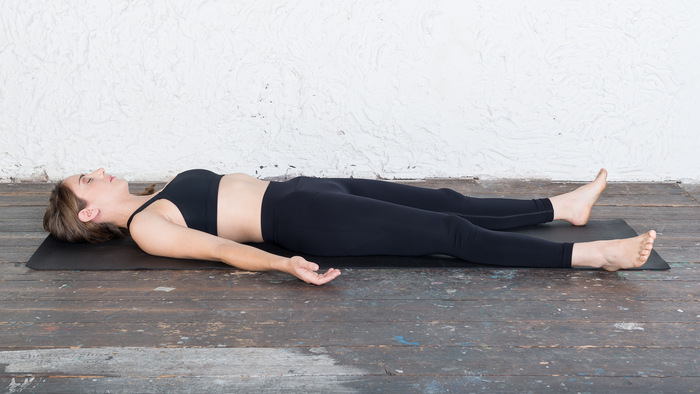
Corpse Pose, also known as Shavasana, is a grounding yoga pose for the Root Chakra that boosts your sense of stability and connection to the earth. As you practice this pose, let yourself be fully supported by the earth beneath you and let go of all the tension in your body. Repeat to yourself “I am safe, I am supported” with each inhale and exhale.
2. Sun Salutations (Surya Namaskara)
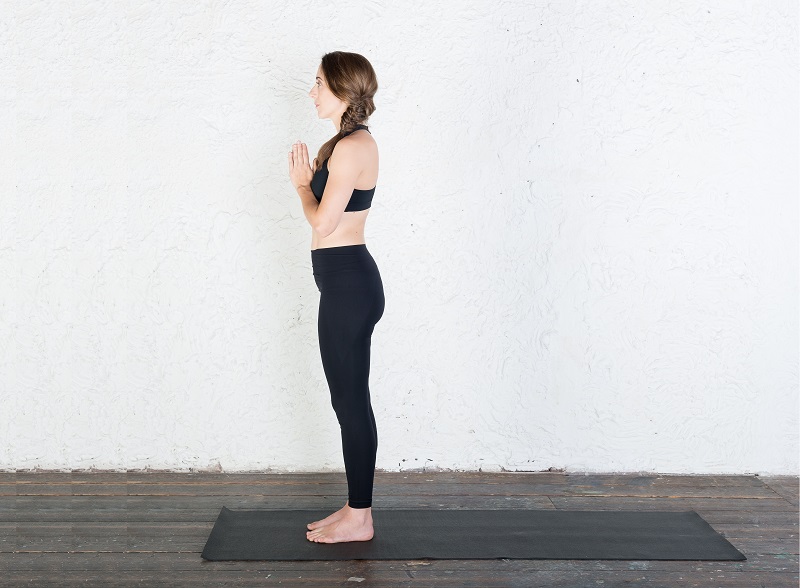
Sun Salutations help you tap into that sense of inner strength and connection with the earth. You will feel a slow and steady heat building from within as you connect with each inhale and exhale. You will eventually notice the mind surrender to the current moment as you work your way deeper into your moving meditation. Close your eyes if you feel comfortable doing so.
3. Child’s Pose (Shashankasana)
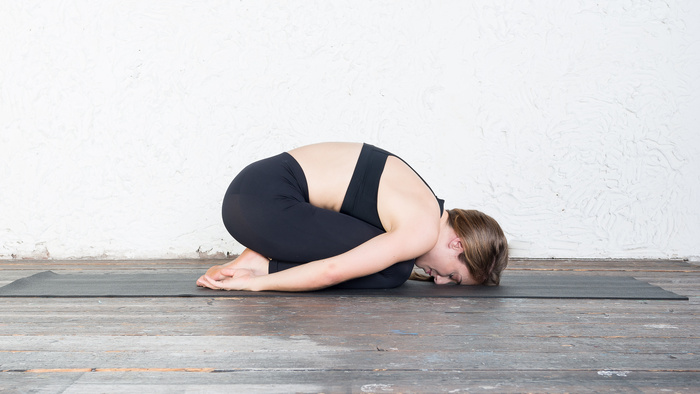
Let your whole body relax. Notice how it feels to be completely supported by the ground beneath you. Welcome this balance of surrender and support to carry you through your practice.
4. Half Bridge Pose (Ardha Setu Bandhasana)
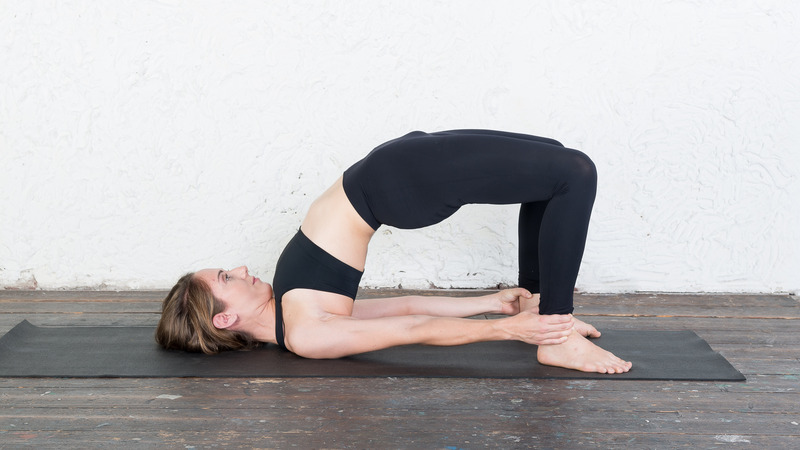
Half Bridge Pose firmly roots your feet into the earth. At the same time, the spine releases excess Root Chakra energy and stimulates the Throat and Heart Chakra.
5. Easy Monkey Pose (Sukha Hanumanasana)
This pose offers an intense stretch for the psoas and quad muscles. These muscles are associated with our flight-or-fight mechanism and are deeply connected to the first chakra energy center. Take five breaths here, giving your muscles time to transform any residual fight-or-flight energy into a courageous yet calm inner strength.
6. Garland Pose (Malasana)
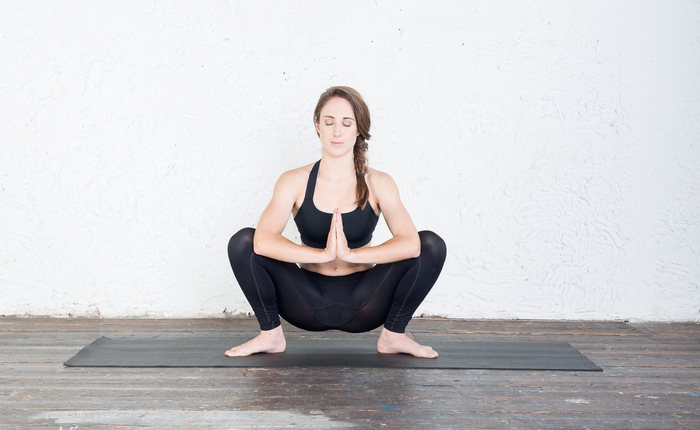
Our feet are our roots, and through the feet, we feel the energy of the earth. Garland Pose plants us firmly in the earth, while opening the hips and promoting Apana Vayu in the body. To awaken the fascia of the soles of your feet, gently tuck your toes under as you rest on your knees. Hold for one minute before releasing. Repeat three times.
7. Standing Forward Bend (Uttanasana)
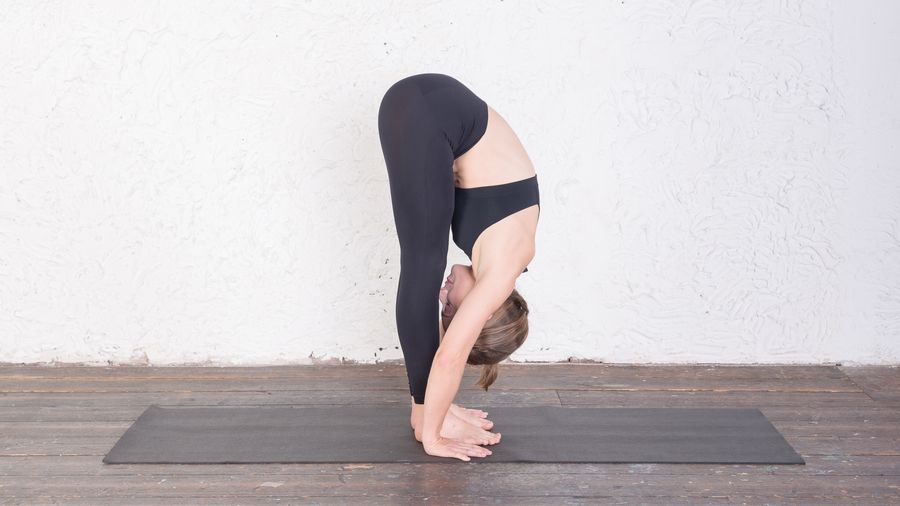
A fabulous pose to ease a busy mind, Uttanasana helps us find center and calmness. At the same time, it slowly stretches the hamstrings and relieves tension in the entire back.
8. Warrior II (Virabhadrasana II)
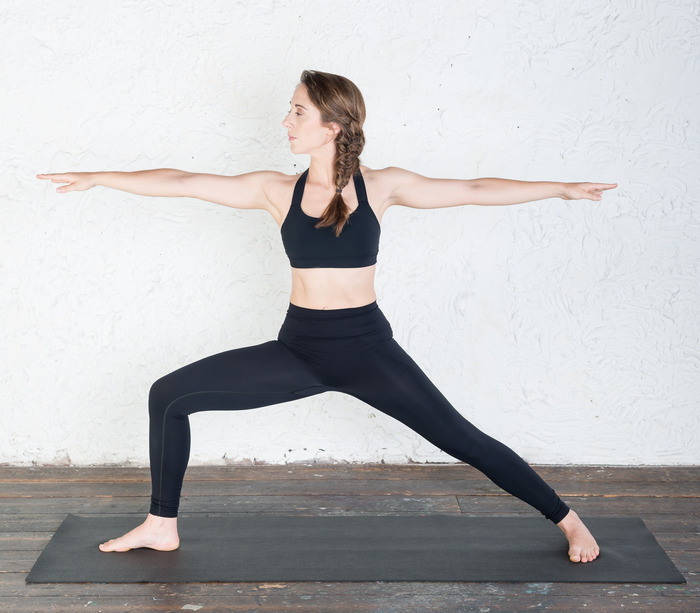
Virabhadrasana means "fierce warrior”. This yoga pose for the Root Chakra uses the body’s natural flow of energy to stimulate it while both feet are firmly on the ground. Practicing Warrior II will help you dig deeper into your inner reserves of strength and determination.
9. Tree Pose (Vrkshasana)
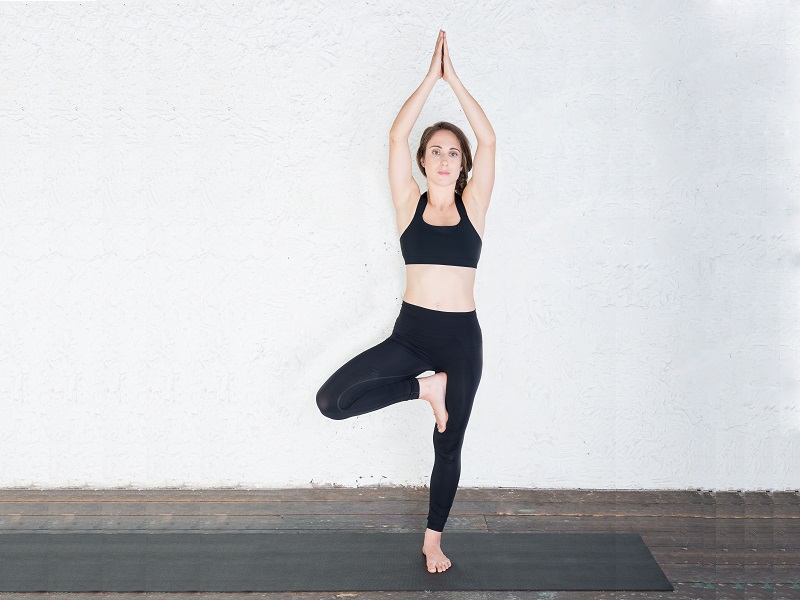
Tree Pose, or Vrkshasana, is a powerful asana that improves balance, concentration, and focus. This posture stimulates the Muladhara energy, balancing the function of large intestines and adrenals. It also strengthens and tones the tendons and ligaments of the feet while relieving the stiffness in the hip joints, groin, and inner thighs.
10. Mountain Pose (Tadasana)
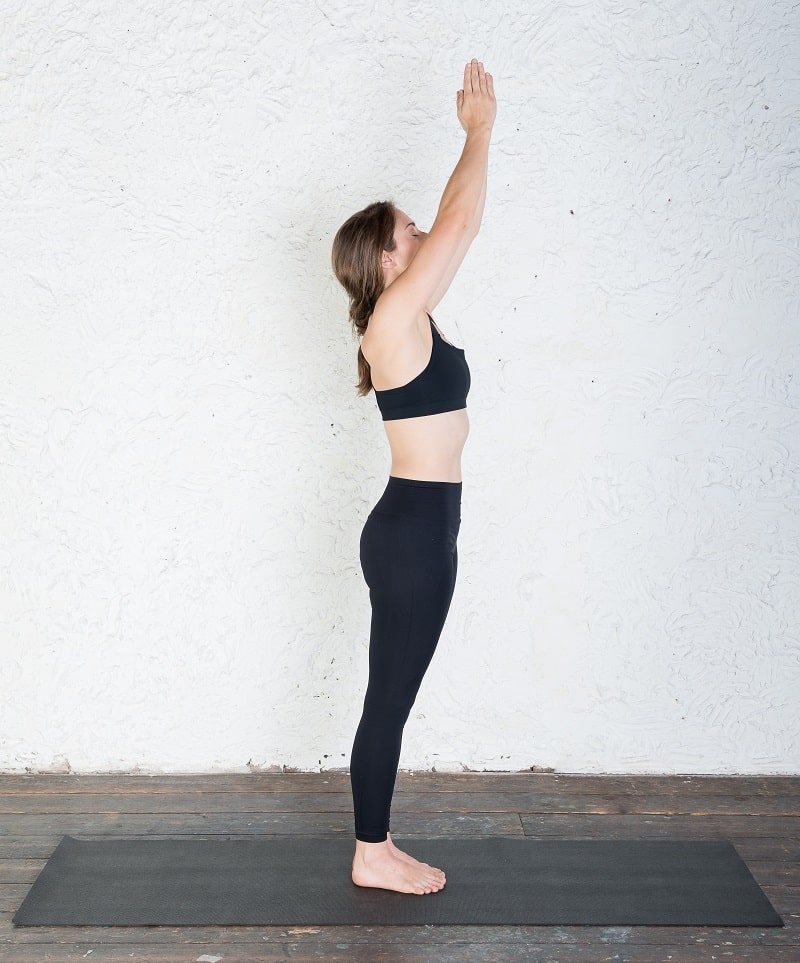
Mountain Pose, or Tadasana, provides strength to spinal muscles and improves posture. This posture for the Muladhara Chakra restores the body’s natural alignment. Practicing this asana regularly expands mental awareness by experiencing calmness and peace of mind. Balancing and relaxing in the Mountain Pose allows us to feel centered and focused.
Reconnecting with Nature
Nature therapy is one of the most effective ways of healing not only the Root Chakra but our whole being. As we spend more time indoors due to modern work culture, we lose our connection to nature and earth. Lack of exposure to nature can be toxic and mentally draining. This creates anxiety, lack of self-confidence, and energy blockages.
Sometimes, the only therapy that we need is spending time walking in rejuvenating nature. The feeling of the grass beneath your feet, the smell of the ocean breeze, the sound of the chirping birds, and a moment of solitude underneath the shade of a tree bring peace and harmony.
Final Thought
When the Muladhara Chakra is awakened and energy is flowing freely, it brings positivity in all aspects of our lives. A healthy and balanced Root Chakra creates a strong connection to our earthly instincts. It improves overall confidence and increases the sense of self-worth. The energy of this chakra allows everyone to harness courage and perseverance during challenging times.

Sign up for our newsletter and get exclusive access to a free guided meditation and lecture with master teacher Ram Jain.


